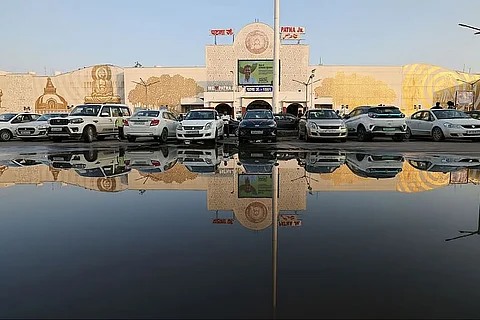

Patna, the capital of Bihar and a Smart City, is changing at a rapid pace. But traffic jams on its roads continue. The city still does not have a definitive Comprehensive Mobility Plan (CMP) yet.
New roads and bridges and the number of private and city-run public transport have expanded. Work on the metro rail is going on in full swing. Diesel vehicles have switched to Compressed Natural Gas (CNG). A 440-metre-long underground walkway (subway) has been built to connect Patna Junction and the multi-modal hub. The route has facilities like escalators, travelators, lifts and ramps, which are helping commuters to move easily. But still, commuting even 10-15 kilometres within the city is difficult for the commuters.
The four-storey multi-modal transport hub built in front of Patna Junction has arrangements for parking of vehicles, city buses, auto rickshaws and taxis. Despite this, autos and e-rickshaws continue to flood the roads carrying passengers at exorbitant fares, Down To Earth (DTE) found.
Hundreds of people lined up at the 20.5-km JP Ganga Path, which connects Dibarganj in the eastern part of Patna with Digha in the west. This recently built bridge has been termed ‘Patna’s Marine Drive’. Rajiv Kumar, who has come from here on a motorcycle to take a view of the Ganga, told DTE, “I ride a motorcycle every day in the city for a private cab agency company. Since there is no public transport here, I often get customers for the ride from here to within the city quickly.”
Kumar says bikes have emerged as an easy option for Patna’s crowded commute. “Thousands of youths like me are now earning a livelihood by riding bikes. They get a fare of up to Rs 250 for a distance of seven-eight kilometres.”
Vishnu Kumar, who works at a shop on Boring Road, one of the busiest areas of the city, waits for a bus. “There are no government city buses on this road. I commute every day from Punpun, 16 kilometres away, to Patna for work.”
He said there is no bus service to Punpun and sharing autos charge around Rs 60. That is why he comes and goes by train every day. For this, he gets regular monthly season tickets, which saves him about 50 per cent in fares every day.
Vishnu said, “In the morning and evening, a large number of working class people and students coming from urban areas around Patna Junction take the train. But the bogies are so crowded that sometimes it becomes difficult to climb. The short-distance trains are not regular and their time table is also messed up. Patna, with a population of 2.5 million, is in dire need of a local train.”
There are at least 10 major stations in the city area and adjoining semi-urban areas of Patna where mainline Electric Multiple Unit (MEMU) trains stop or run regularly. They are used by working class people, students, and businessmen who travel daily. Rajendra Nagar Terminal, Patna Sahib, Gulzar Bagh, Danapur, Pataliputra Junction, Phulwarisharif, Neura, Punpun and Fatuha are important stations. Apart from these MEMUs, the Intercity Express running from Patna Junction is also crowded in the morning and evening.
According to a station official, around 30 per cent of the population commutes from Patna and its surrounding urban areas on a daily basis. Dilip Chaudhary, who transports vegetables from Mithapur, about two km from Patna Junction to Digha every day, said he would not be able to ply his trade if it were not for the train.
During the 10-km journey from Patna to Patna City, DTE found that going from Ashok Rajpath to Patna City by public transport is a difficult task. Ankush Kumar, who runs a private cab, said there was a traffic jam for hours in the morning and evening. “That’s why we don’t go on this road. This is the commercial hub of the city, where roads are narrow and encroachments lead to hours-long traffic jams.” However, on June 11, Patna’s first double-decker flyover was opened at Ashok Rajpath, which now covers the distance of 45 minutes in 15 minutes.
The first corridor of Patna Metro, the Blue Line, covering about 6.5 km between Patna Junction and ISBT, is planned to be started on August 15. At the same time, Hardings Park Terminal will be built near Patna Junction, which will aid local train operations as well.
There is still a severe shortage of walkways and cycle tracks. Efforts to ease traffic from Nehru Path to Gandhi Maidan seem to be effective on the roads. However, there are still 145 government city buses, including CNG and electric buses, running under the Bihar State Road Transport Corporation in Patna. Twenty pink buses, intended to provide safe travel to women, are operating regularly. At the same time, about 300 private buses are providing CNG-based city services.
According to the Jawaharlal Nehru Urban Renewal Mission, at least 1,000 to 1,250 buses are needed for Patna’s 2.5 million population. But only 465 buses are available, which means there is a severe shortage.
Despite all the new facilities and construction work, the biggest problem is air pollution. However, work is also in progress to prevent air pollution. The city ranked 14th out of 47 cities with over a million people in the 2014 National Clean Air Survey. Its ranking was 29th earlier. As a result, an incentive grant of Rs 30.39 crore has been received from the Centre, which will be used in measures to prevent pollution.
This article is part of our series on how India moves, which looks at the relationship between air quality and human mobility in cities and towns.